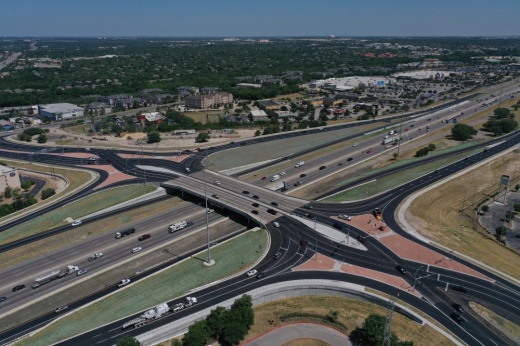The Texas Department of Transportation marked the opening of a diverging diamond interchange at 12415 N. I-35, Austin, with a ribbon-cutting ceremony June 22.
“Folks need to get from point A to point B, and that's where the Texas Department of Transportation comes in,” Texas Transportation Commission Chair J. Bruce Bugg, Jr. said while addressing a group of TxDOT employees and guests standing on the side of the busy northbound I-35 and Parmer Lane exit.
A diverging diamond interchange creates a diamond-shaped pattern and addresses congestion by allowing vehicles to travel more quickly through busy intersections. It increases traffic flow by temporarily shifting traffic to the left side of the roadway, allowing through traffic and left-turning traffic to proceed through the exchange simultaneously. This eliminates the need for left-turn signals.
The diverging diamond interchange is a part of the Texas Clear Lanes project and is expected to alleviate traffic conditions that create a bottleneck at the I-35/Parmer Lane intersection. The project also reconstructed the northbound intersection bypass lane, added a southbound I-35 bypass lane, constructed right-turn lanes and dual left-turn lanes at the intersection of Parmer Lane and North Lamar Boulevard, and improved bicycle and pedestrian accommodations throughout the corridor.
According to Bugg, the $33 million construction project was funded in part by “Proposition 1 and Proposition 7 funding [that] has allowed the state of Texas to leapfrog over other states that have not provided their own transportation funding.”
In 2014, Texas voters approved the ballot measure known as Proposition 1, which authorized transportation funding for the state highway fund to assist in the completion of transportation, construction, maintenance and rehabilitation projects for nontolled roads. The following year, Proposition 7 authorized a portion of sales and use taxes and a smaller portion of motor vehicle sales and rental taxes to be used to construct, maintain or acquire rights of way for nontolled public roadways.
“We built something for the next generation. And in the future, more and more cars will be alternatively fueled; there will be more microbuses, and because of this design, there will be more pedestrians and more cyclists who are going to go over there [across the highway] get themselves a bagel,” said state Rep. Celia Israel, who saw the construction begin and come to its completion during her tenure.






